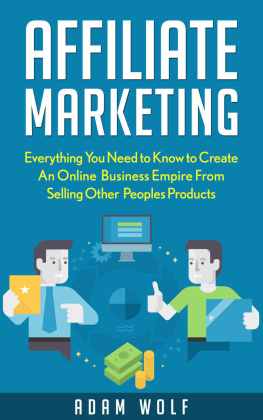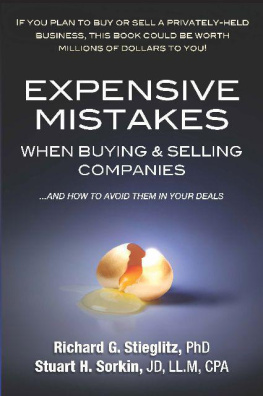Copyright 1998 by Robert M. McMath and Thom Forbes
All rights reserved. No part of this book may be reproduced or transmitted in any form or by any means, electronic or mechanical, including photocopying, recording, or by any information storage and retrieval system, without permission in writing from the publisher.
Published by Three Rivers Press, New York, New York.
Member of the Crown Publishing Group.
Random House, Inc. New York, Toronto, London, Sydney, Auckland
www.randomhouse.com
THREE RIVERS PRESS is a registered trademark and the Three Rivers
Press colophon is a trademark of Random House, Inc.
Originally published by Times Books in 1998.
Library of Congress Cataloging-in-Publication Data
McMath, Robert M.
What were they thinking?: marketing lessons you can learn from products that flopped / Robert M. McMath and Thom Forbes.
1. New productsMarketing.
2. New productsMarketingCase studies.
I. Title.
HF5415.153.M348 1998
658.802dc21 97-20804
eISBN: 978-0-307-79364-5
v3.1
I dedicate this book to Jean Huber McMath, my wife, without whom I would not be able to do what I do, and to Charles E. Mittelstadt, former director of CAS, the information facility of the Interpublic Group of Companies, Inc., without whom I wouldnt be what I am.
R.M.M.
Those who cannot remember the pastare condemned to repeat it.
George Santayana
Failure is an opportunity.
Lao-tzu
You cant turn a sows ear into a Veal Orloff, but you can do something very good with a sows ear.
Julia Child
ACKNOWLEDGMENTS
Many people shared their wisdom and support over the years. Our families gave us both, and did so with great patience and love. Our agent, Joel Fishman, realized the potential of this project, helped us shape the proposal, and got the deal. Our editor, John Mahaney, knew where he wanted us to go and made sure that we got there. His assistant, Eleanor Wickland, ably assisted us on the last leg of the journey.
We are also indebted to scores of people weve talked to over the years whose insights helped us immeasurably, although they may not agree with our conclusions. We will not single any out. We wish to acknowledge their contributions, along with those of the exceptional journalists with whom we once worked at Adweeks Marketing Week, with a long sweeping bow and a doff of Bobs vintage top hat.
CONTENTS
INTRODUCTION
Some nights at quitting time, after my clients have returned to their hotel rooms and I need to wind down after a day of fielding questions, I wander around my New Products Showcase and Learning Center here in Ithaca, New York. Ive lost track of precisely how many once-new products line my gunmetal gray shelves or are packed away in storage, but 80,000 is a good estimate. As I walk by them, I cant help but notice that there are a lot more fizzlers than sizzlers. Duds. Losers. Wipeouts. Bombs.
I dont mean to be glum.
I started to gather new products almost thirty years ago for the same reason that scholars collect books: so that I could learn from them and teach others in turn. Im not a morbid man. I like laughter and people of good cheer. I believe that smart ideas triumph over adversity and that a well-thought-out strategy, pursued with vigor and honesty, will prevail in the marketplace.
Well, most of the time.
Now that I look back, it was inevitable that I would end up with the worlds largest Library of Losers. Even the best marketers in the world, like great baseball players, get to first base less than 40 percent of the time. Far less. And home runs are rare indeed.
Campbell Soup Company is among the most successful marketers of this century, for example. Among the more than 270 examples of Campbells soups in my collection, however, are quite a few clunkers. Campbells Fresh Chef, a line of refrigerated soups, was a bomb. So was Campbells Creamy Natural Soup. Microwave Chunky Soup failed, too, as did Comin Home Real Soup and Recipe Mix. And lets not forget Campbells Souper Combos, which flopped despite a $10 million ad blitz in its final year.
Any winning marketer will have a similar lineup of losers, in fact.
As I stroll about the showcase, I am tempted to speak to some of the products. Im particularly drawn to the ones that should have made it but didnt.
So whats a nice product like you doing in a place like this? I want to ask.
Now dont write me off as wacky. I assure you that even though these products dont talk back, they have a lot to tell us.
Sometimes the name was awful. Or if the name was great, maybe it tasted horrible. Perhaps its advertising was so clever that nobody knew what it could really do. Or perhaps there was no advertising or promotion at all and it withered like fruit in a frost. Maybe it was too pricey for the marketplace. Or too cheap.
Anyone who ever sold lemonade as a kid knows how difficult it is to market a product. First youve got to convince the bankers (your parents) that youve got an idea thats worth backing. Then youve got to get the flavor right. Not too tart; not too sweet. Youve got to decide at which corner to build your stand, well aware that some envious kid from the next block (whos inevitably bigger) is going to set up right in front of you. You need to decide what price to chargeand then have the guts to drop it when Sluggo undercuts you by a nickel. And you cant be bashful about collaring every friend and grown-up who ambles by. Hard sell or soft sell, barkers shout or engaging smile, you need to draw attention to yourself.
Alas, I cant tell you that Everything You Ever Needed to Know About Marketing You Learned at the Lemonade Stand. Its just not that simple. No lemonade entrepreneur I ever knew had to pay a slotting fee, worry about a competitors $50 million advertising budget, or figure out office politics.
New products succeed when just about everything that needs to go right does go right. Thats a tough assignment. But if you realistically examine your concepts at the outset, rigorously question your assumptions as you develop them, and remain flexible enough to make necessary adjustments when you run into snags and hitches, your odds for success will improve substantially.
I would also suggest that you expand your definition of success. You are, as far as Im concerned, a successful new-product developer if you abandon ideas that are destined to fail. Sometimes youll read the signs of failure on the drawing board. Other times you may go all the way to a market test before youre able to spot some flaw. Im not suggesting that you backpedal on a gutsy idea or yank a product from distribution at the first sign of difficulty. Its easy to be a naysayer or nitpicker. You need to be bold to succeed. But you should never hesitate to kill an untenable product before its costs get out of hand.
Of course, you have to know whats tenable and whats not. Thats where this book comes in.
If theres one thing Ive learned during my years of collecting new productsinnovations, idiosyncrasies, and idiocies alikeits that the odds for successful marketing increase exponentially if you are aware of what has succeeded and failed in the past. There are more losers than winners on my shelves simply because thats the way it works in the real world. But the winners have stories to tell, too.














